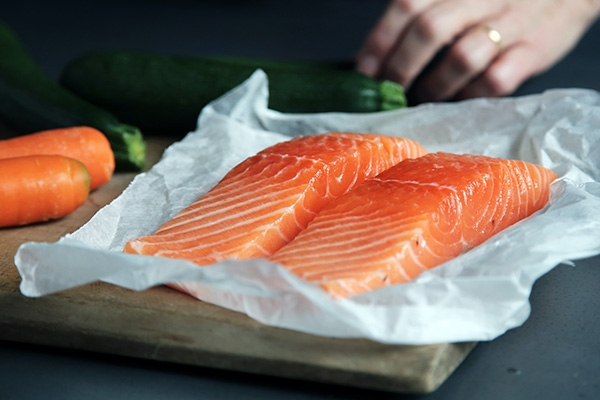April 12, 2023

Salmon is the second most consumed seafood in the United States. Home cooks love this fish for its vibrant color, flaky texture, and high levels of Omega 3 fatty acids. However, some cooks might not realize that not all salmon varieties are the same. If you’ve ever wondered what’s the difference between Coho and Sockeye, or if you should buy farm-raised, we explore all the main types of salmon below.
What are the Different Types of Salmon?
It might surprise home chefs that there are six different varieties of salmon, each with its own flavor profile.
6 Wild Salmon Varieties
1. Chinook: Also known as King salmon, Chinook can be found in the Pacific Ocean from Alaska to Southern California. Many consider this type of salmon to be the highest quality to buy. It’s exceptionally high in Omega-3s and fat, making it healthy, rich, and buttery. Due to their diet of ocean crustaceans, Chinook flesh is a striking pink color.
2. Sockeye: It’s easy to spot sockeye salmon. This fish has a brilliant red color that is unmistakable. They feed primarily on zooplankton and can be found in saltwater and freshwater environments. They are often caught in rivers during their spawning cycle in the summer. They have a bold flavor and more intense smell than other salmon, and their season runs from July to October. You’ll often find sockeye salmon as fillets at your wholesale grocery store.
3. Coho: Coho is a smaller-sized salmon between Chinook and Sockeye salmon in terms of fat content and flavor. Coho has a subtle flavor and medium fat content. Their flesh is pink and delicate. You can tell a coho apart from others by its shimmery silver skin.
4. Keta: Keta is a smaller, low-fat salmon with a mild flavor. While you will find wild-caught Keta smoked or canned, its roe is what the fish is most prized for. Keta roe is large, salty, and delivers a satisfying caviar “pop.”
5. Pink: Maxing out at only 30 inches long and weighing only 5 pounds, these tiny salmon still pack a flavor punch. Pink salmon, named for its pale pink color, are often canned or smoked.
6. Atlantic: The sixth salmon you are most likely to find while out shopping is the Atlantic salmon. While this type once flourished in the wild, Atlantic salmon is typically farm-raised due to overfishing. As the name suggests, these fish come from Atlantic waters. Their flesh is an orangeish-pink, and they contain good amounts of marbled fat. Atlantic salmon fillets are often found in stores, but you can sometimes find them whole.

Wild-Caught Salmon VS. Farm-Raised Salmon
When shopping at your wholesale grocery store, you will likely see salmon labels indicating if your fish is wild-caught or farm-raised. As the name suggests, wild salmon is caught in its natural environment, including rivers, streams, lakes, and oceans.
Farm-raised salmon are grown in an aquaculture that breeds the fish and raises them to maturity. Farm salmon are fed high-fat, high-protein foods to mimic their wild diet. While wild salmon is abundant, 70 percent of salmon sold in the U.S. comes from farms.
Should You Buy Wild or Farm-Raised Salmon?
There has been some debate on which salmon is the best to purchase. Farmed and wild salmon contain large amounts of Omega-3 fatty acids. Omega-3 can improve heart health, lower blood pressure, and promote good cholesterol levels. However, wild salmon and farm-raised diets differ, so their nutrient index varies. Wild salmon contains higher Omega-3s and minerals, especially iron and calcium. Farm salmon has more vitamin C but can also contain more saturated fats and calories.
Regarding cost, you’ll find wild salmon to have a higher price tag, so farmed can be a more affordable option. Depending on your specific needs, you can find high-quality salmon in both wild and farm varieties.
Stock Up On High-Quality Salmon and More
Whether you are looking for sockeye salmon filets, smoked keta, or other fresh seafood, we have everything you need at US Foods CHEF’STORE. You discover aisles of high-quality products at exceptional prices, perfect for your home-cooked meals and grocery budget.
Visit one of our many locations or get our exceptional foods delivered directly to you.